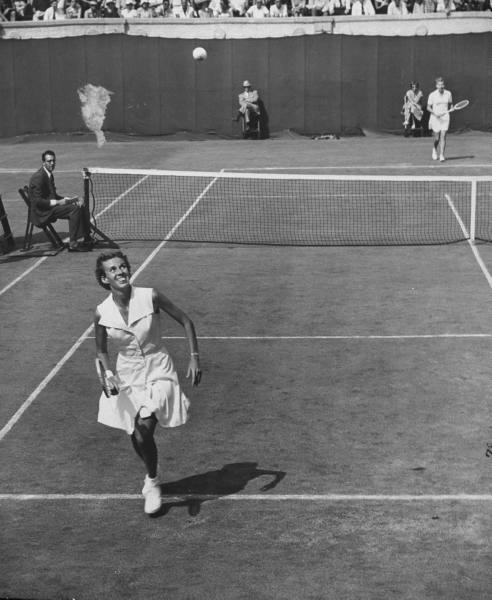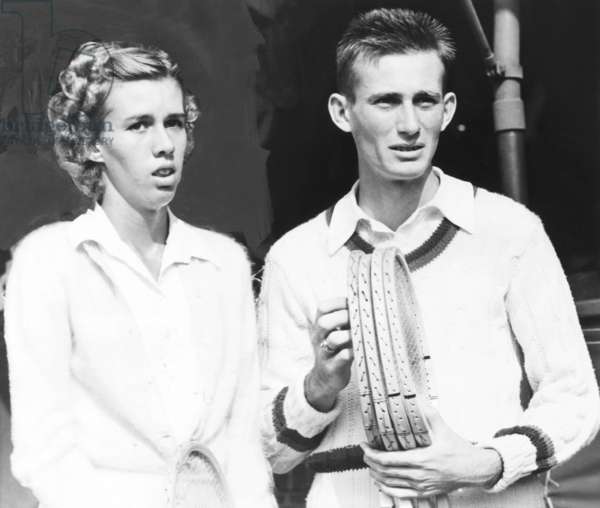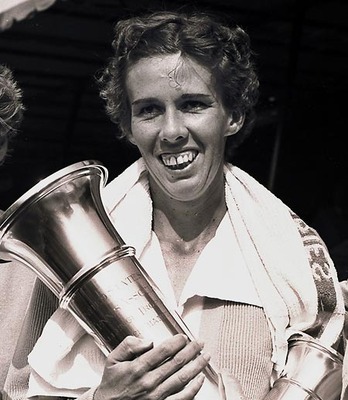In 2022, I’m counting down the 128 best players of the last century. With luck, we’ll get to #1 in December. Enjoy!
* * *
Doris Hart [USA]Born: 20 June 1925
Died: 29 May 2015
Career: 1938-55
Played: Right-handed (one-handed backhand)
Peak rank: 1 (1951)
Peak Elo rating: 2,317 (1st place, 1953)
Major singles titles: 6
Total singles titles: 85
* * *
Doris Hart may well have been the greatest mixed doubles player of all time.
She won 15 majors in the discipline, more than any other player in the amateur era. Only Margaret Court has won more since. From 1951 to 1955, partnering Frank Sedgman and Vic Seixas, Hart entered the mixed event at 13 slams. She won all 13.
For those of you who are new to the series: The Tennis 128 ranking doesn’t consider doubles results–mixed or otherwise. Doris’s place on this list is due entirely to her sterling singles play. Her doubles performances were worthy of an even higher position. On top of the mixed feats, she picked up 14 women’s doubles majors, 11 of them with her best friend, Shirley Fry.
In the 1980s, the author Stan Hart (no relation) asked Louise Brough if there were any doubles teams that she and Margaret Osborne duPont feared. That pair won 20 majors themselves, but Brough had a ready answer: “Doris Hart with anyone.”
Doris competed so well against men because she’d been playing against men her entire life. For years, the face across the net belonged to her older brother Bud. Bud was a promising junior himself, and he reached the top 20 in the United States rankings before enlisting in the Navy. Yet he seems to have realized early on that his role on the national tennis stage was as a mentor to his sister.
The Harts learned the game through endless one-on-one practice, beginning when Doris was 10. Bud was the analyst of the pair. They’d see adults play on a nearby court and try to mimic their strokes. Later, when Doris began to play junior tournaments around the country, Bud eyed the competition and puzzled out what was missing from his sister’s game. They got back to work until each gap was plugged.
One of the skills he tried to drill into Doris was self-defense at the net. With the four-foot, six-inch 13-year-old standing in volleying position, he would hit balls at her as hard as he could. When she complained, he said, “If you return them you won’t get hit. Get back to the net.”
Bud also made sure that his sister became an expert at the half-volley. The pair would draw a line two feet behind the baseline. If Doris stepped behind it, she lost the point. Throughout her career, well-wishers would tell her she was taking too many chances by maintaining such an aggressive court position and taking half-volleys near the baseline. They were risky shots for other women, but not for her.
Hart’s one weakness was mobility–we’ll come back to that in a minute. Find a partner who could do all the running, and there was no stopping her. Seixas later said:
The crux of it is that she could do everything except run. She had great racquet control, volleying, half-volleying and… well, she could do everything. [S]he played mixed doubles with Sedgman and me, who I think were the two best runners in the men’s game. So she had just what she needed.
When Hart won the singles title at the 1954 US National Championships, she completed the career “boxed set” of major titles. That’s a singles, doubles, and mixed doubles championship at each of the four grand slam tournaments. She was the first player ever to do so, and only Court and Martina Navratilova have matched her feat since.
* * *
It’s a miracle that Doris became a competent tennis player at all, let alone one of the greatest of all time.
When she was 15 months old, she developed a bone infection in her right knee. One doctor was ready to amputate, but another was able to keep the damage in check with less drastic measures. Still, her physical development was delayed. She would remain bowlegged for the rest of her life, so much so that many fans assumed she had recovered from polio.
It was hardly her last childhood ordeal, either. Hart went through a bout of double pneumonia. When she was nine years old, she needed an operation after developing a bilateral hernia. Recovering from surgery, she could watch tennis players running around on the courts outside her window. That sparked her imagination, and when Bud brought home a tennis racket soon after, an obsession was born. Growing up in Miami, Bud and Doris could play year round, and they took full advantage.
Within a few years, the pint-sized teenager was playing on even terms with adults. In the summer of 1938, her father’s business took the family to Memphis, Tennessee. 13-year-old Doris won the city championship there, and she added the Arkansas state title for good measure. A trip to Philadelphia for the national junior tournament ended with an early-round defeat, but not before Bud picked up enough ideas to fill the Hart family practice sessions for the entire winter.
The siblings noticed that Doris’s second serve paled next to the American Twist deliveries of the prospects from California. So she learned one. They discovered the effectiveness of a drop shot on grass courts. So she worked on that shot until her touch was impeccable. It became one of her primary assets.
They did plenty of movement drills, too, but as Hart later wrote, “[I]t was still obvious then that I was never going to be labelled a ‘retriever.’ The remedy was to develop an offensive attacking game that required the minimum of running.”
When the young woman sprouted to her full height of five feet, nine inches, her offensive weapons went from capable to crushing. People later learned the saying, “As her service goes, so goes Doris.” More often than not, Doris and her serve went straight for a quick victory.
* * *
Doris won the national junior title in 1942, then defended it in 1943. By then, she was a force on the adult circuit as well. The 16-year-old made her first appearance at Forest Hills in 1941, where she nearly upset Pauline Betz, the eventual finalist and 1942 champion. The next year found her in the quarters. In 1943, she cracked the final four, where she lost another close battle with Betz.
It seemed to be just a matter of time before she became a champion in her own right. Hart was the Forest Hills runner-up in 1946 (to Betz again), and she came in second at both Roland Garros and Wimbledon the year after that. You could hardly blame her for developing a complex. By the end of the 1947 campaign, she had reached 13 major finals–nine in women’s doubles alone. She had only a single title to show for it.
With Bud, the young star had studied strokes and basic tactics. Betz, Brough, and Osborne were older and savvier. After the war, Doris went to the University of Miami, where she could extract the wisdom of veteran coach Mercer Beasley. Beasley had developed promising youngsters including Ellsworth Vines and Frank Parker, and he encouraged Hart “to think more on the court, to use strategy instead of strokes that seemed expedient on the spur of the moment.”
No one ever questioned Doris’s raw talent. Alice Marble wrote to her in 1944, “[Y]ou have much more natural ability than anyone else and you owe it to yourself to be a champion because God only has a few chosen people in tennis and you are one.”
With Alice Marble and the Supreme Being in one’s corner, what could go wrong? In Hart’s case, there were many answers. Bad line calls, lost concentration, poor playing conditions… each one of her near-misses seemed to have an explanation.
It took a piece of luck to reverse the trend. In the 1947 Wimbledon women’s doubles final, Doris and Pat Todd faced the “two bombs”–Osborne and Brough. Brough served for the match at 5-3 in the decider and ran out to a 40-love lead. Louise possessed the best serve in the women’s game. Somehow, Hart and Todd scrambled back, both sides playing brilliant tennis. When the challengers finally created a match point of their own, a dubious line call went against Osborne and Brough. The umpire couldn’t be budged. The final set, and the match, went to Hart and Todd, 7-5.
Doris had her first major title, six years after her first appearance at Forest Hills. She would go on to win 34 more.
* * *
A number of factors helped promote Hart from perennial bridesmaid to champion. One was the departure of Betz, who turned pro early in 1947. Pauline had beaten Doris in 19 of 21 meetings, but they wouldn’t play again until Hart herself joined the professional ranks in 1955.
Doris’s preferred explanation was her improved concentration. She credited Beasley with the boost in her mental game. The change in her fortunes at Wimbledon in 1947 didn’t hurt, though it wasn’t a magic pill. She lost all three finals–each one to Brough–at the All-England Club the following year.
A third reason was her trip to Australia for the 1948-49 season Down Under. During the war, Hart played one partial season after another, in part because of her attempts to get a college education. For the first time, she was able to spend the winter facing top-flight competition. There was a confidence boost, too. At the 1949 Australian Championships, she picked up two of the three titles. She won the singles and mixed doubles (her first major victory with Sedgman) and finished second in the women’s.
Doris never really lost the momentum she gained on that Australian trip, even when eye surgery forced her to skip Wimbledon in 1949.
The association with Sedgman would last through the 1952 season, when the Australian joined Jack Kramer’s professional troupe. In 1949, Hart turned to Shirley Fry as her regular partner for women’s doubles events. They would win all nine majors they entered together between 1951 and 1953.
It all came together for Doris at the All-England Club in 1951. She cruised through the singles draw, setting aside Beverly Baker Fleitz in the semi-finals with the loss of only four games. The women’s singles, women’s doubles, and mixed doubles finals were played on the same day, and as in 1948, Hart figured in all three.
Doris was even better against Fry in the final. The two friends knew each other’s games inside and out; each knew what the other had eaten for breakfast, since they roomed together on the road. Hart confounded her pal’s expectations, relying more on variety and risky net attacks than her normal pattern. It couldn’t have worked any better. In just 34 minutes, Hart won her first Wimbledon singles title, 6-1, 6-0.
Shirley said after the match, “I am glad that Doris won. She deserves a break after all these years.”
Hart and Fry beat Osborne and Brough for the doubles title, despite Shirley picking up an ankle strain in the early going. Finally, Hart and Sedgman straight-setted an Australian duo for Doris’s third championship of the day.
One man who was pleased–if not surprised–by Hart’s triumph was Wimbledon’s resident teaching pro, Dan Maskell, who would later gain fame as the BBC’s voice of The Championships. Maskell had seen all the greats, yet it was Doris’s effortless, powerful forehand that inspired him to chuck his own and learn to hit it like she did. To him, Hart was “one of the most outstanding women ever to grace a tennis court.”
* * *
She still, however, was not the champion of her own country.
In 1949, she recovered from eye surgery quickly enough to reach the Forest Hills final, where she lost to Osborne. Margaret beat her again in the 1950 title match. In 1951, she fell in the semi-finals to the 16-year-old phenom Maureen Connolly. Connolly reigned over Doris as she did the rest of the field, recording final-round victories at Forest Hills again in 1952 and 1953.
Hart was 28 years old. She had played five singles finals for the US National Championship, four of them in the last five years. She was still waiting to win a single set.
In 1954, the field opened up in the worst way possible: Connolly was injured in a horse-riding accident and would never play competitive tennis again. Doris didn’t rejoice–she had planned to play doubles with Little Mo that summer–but she did capitalize. In her first five matches at Forest Hills, she conceded only nine games. She clobbered Fry again in the semis, beating her friend 6-2, 6-0.
She faced another veteran, Louise Brough, for the title. They had met at least 31 times on the singles court, dating back to a first encounter at the national girls’ tournament 14 years earlier. Their list of doubles clashes was even longer. They had even teamed up to win a major, when they traveled to Australia together in 1950.
Both women were champions, but neither had ever gotten comfortable at Forest Hills. Hart later wrote:
There was no cause for final-day jitters… but we both experienced something that afternoon. You might say we were terrified–of winning and of losing, and were cautious and erratic throughout the entire match.
They split two sets, and Brough struck first in the decider. Hart faced a match point while serving at 4-5. She saved it with an ace. Louise generated another opportunity at 5-6 but netted a second-serve return. Doris finally realized she could take the title by simply managing her nerves better than Brough did. When Hart reached a match point of her own, at 7-6, 40-15, she played it safe and let her opponent make the mistake.
The title was hers, 6-8, 6-1, 8-6. She won her national title on the 14th attempt. She had felt the pressure from first ball to last, telling reporters afterward that it was “my toughest match.”
It almost goes without saying that at the same event, Doris won the doubles, with Fry. She and Vic Seixas nearly let the mixed final get away from them–Seixas had also won the singles, and both were ready to celebrate–but they recovered in time to claim their fifth of seven majors as a team.
That last monkey off her back, Hart returned in 1955 and defended her singles victory by reeling off ten straight sets. With Shirley, she came in second to Osborne and Brough, but Doris and Seixas were as impeccable as ever. At 30 years old, two decades after she started watching tennis from a hospital bed, she retired from the amateur game. Counting singles, doubles, and mixed, she is credited with over 300 career titles.
Not bad for a woman who couldn’t run.


